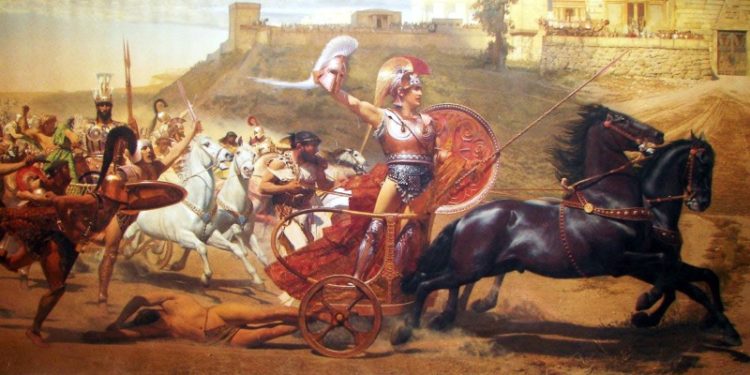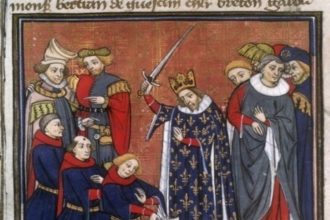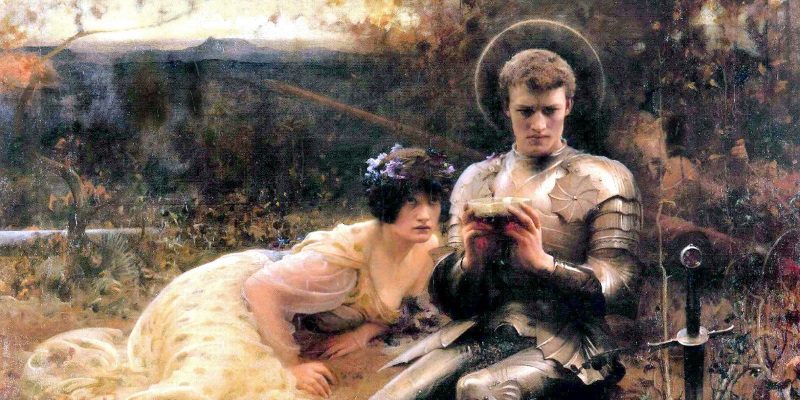The Warlord Class, Part Four

I wound up not finding anything I wanted to pair with the 13th Age commander class for today’s article, but at the same time… there’s enough meat to justify deep coverage. If you’ll open your Book of Common Prayer System Reference Document to page, uh, whatever this page is: Commander. There are some superficial similarities to both the bard and the fighter – about like you’d expect, if you’ve read the History of the Warlord up to this point.
Part One | Part Two | Part Three | Part Four
13th Age: The Commander
Thematically… uh, well, I don’t have access to 13 True Ways, so I’m not sure what flavor text they include here, but I’m 99% sure that class name is all we need to know up-front. That said, there are a few unusual choices coming up, so I can’t help but wonder if they’re clarified in the actual book in some way.
- +2 Str or +2 Cha, but not stacking with your racial bonus.
- The suggested backgrounds seem a little… odd. I’m not here to slut-shame, but I have to say that “exotic dancer” makes me wonder if that’s printed in the book, or if someone felt saucy while typing it into the SRD wiki. It’s just not within even the outer reaches of what I’d expect.
- The commander’s Armor Class is positioned between the bard’s and the fighter’s, with the apparent expectation that they’ll choose light armor and maybe a shield rather than take the attack penalty for heavy armor. However, one of the Class Talents fixes this and favors heavy armor. More on that in a bit.
- Similarly surprising, their weapons chart looks like they should be using light or simple weapons, even more so than the bard. Odd choice here, and again addressed with a Class Talent.
- A reasonable number of hit points – same as the bard.
- The core gameplay loop is that you generate command points through a few different means, including fighting on the front lines or hanging back and observing the fight. You spend these points on commands. You also gain tactics, which don’t cost anything but aren’t always available. Your number of commands and tactics known comes from the same pool, starting at 4 and scaling to 10; you’re also replacing lower-level commands and tactics with higher-level ones as you go. You start each fight with 1 command point, and lose unspent command points at the end of the encounter.
- Fight from the Front generates command points when you land a melee hit. You’re contributing more to the fight – dealing damage! – but exposing yourself to greater risk and potentially missing with your attack. With some feat expenditure, this starts to look a lot better. This favors Strength, obviously enough.
- Weigh the Odds always generates command points, but doesn’t otherwise make progress in the fight. The adventurer- and champion-tier feats actually look a little more exciting than the epic-tier feat here, but they’re all helpful. This favors Charisma.
- You start with 3 Class Talents from the following list, tacking on another at 5th level.
- Armor Skills lets you wear heavy armor without penalty. The feats attached to this are really cool, including passively generating command points when enemies roll natural 1s or 2s on attacks against you. The baseline feature, though, feels so much like paying a class talent to reach what I see as the default image of the commander class – looking like a fighter.
- Battle Captain is permission to spend command points more often, granting you an additional interrupt action on an ally’s turn if you have a pool of command points sitting around. Tightly limited, but great for exerting a lot of influence in a battle.
- Combat Maneuver lets you lift a maneuver from the fighter class list. So about how the commander is a fighter blend…
- Destined to Lead brings in Icon-related mechanics – when you roll a 5 or 6 on an Icon die, you gain a lasting pool of command points. When spent, they’re gone, but they don’t go away at the end of an encounter. I love the story of this feature – no one has as overdeveloped a sense of their own destiny as a successful battlefield commander (source: every victorious Roman general, Napoleon Bonaparte, etc., etc.). It also calls some of the bard’s fate-related Icon mechanics to mind.
- Forceful Command lets you “overspend” command points when you make an ally roll a d20, to grant additional bonus to that roll. The feat upgrades from this also look promising – starting with extra command points means that you’re meaningfully influencing the battle sooner.
- Into the Fray grants substantial bonuses to initiative or AC to a few allies in the opening round of battle. This sounds odd until you remember that 13A’s Escalation die mechanic is absolutely about making the PCs cautious in the early rounds and bold in the late rounds. With this talent, you cover weaknesses early on.
- Martial Training is for heavy or martial melee weapons what Armor Skills is for heavy armor: allowing you to use gear that seems like it should be the default. Here again, the feat improvements look pretty great.
- Moment of Glory lets you roll a d4 at the start of the encounter, resulting in a bonus you can use to change the outcome of a roll after you know the die result. From a 5e perspective, it looks a lot like “Bardic Inspiration, but less.” In fairness, well, this isn’t 5e.
- Never Say Die accelerates the shift of the battle into your favor (that is, it advances the Escalation Die) when someone on your team eats a critical hit. The feat improvements are pretty appealing.
- Strategist lets you play this as a Str/Int class rather than a Str/Cha class. The feat improvements look like good fun – I especially like that when you do something that affects a random number of allies, you add 1 to the result.
- Sword of Victory lets you stab your way into having more command points – you’re receiving command points as an on-kill effect for 1 non-mook or 3 mooks. The feats just improve that command-point yield in various ways.
- Tactician lets you play this as a Str/Wis class rather than a Str/Cha class. I liked this kind of Class Talent when I saw it in bard and I’m into it here too. As you’d expect from the name, it leans a little more on Tactics than commands, in its feat-improved versions.
That’s the core of the class – everything else is Commands and Tactics. I have some notion of what this class is and how it plays before going through the Commands and Tactics, but it’s like saying you understand the wizard before you look at the spell list. Of the Class Talents as a whole, I feel like there’s a mix of fundamental playstyle-changing options and nice-to-have minor bennies. That’s normal for 13th Age, but it always strikes me a bit oddly.
Before I go on, I want to say that this rest of this is going to be some pretty dry item-by-item commentary. I’m interested in pointers from 13th Age fans on where I’m overestimating or underestimating the value of options.
Commands
There’s a new tier of Commands and Tactics at 1st, 3rd, 5th, 7th, and 9th levels. I think it’ll make more sense in analysis if I handle all of the Commands together, and then all of the Tactics. Remember that Commands are always used on an ally’s turn, which is awesome for keeping the commander’s player engaged in play when it isn’t their turn, and for really creating the sense that they’re cheering for the target player. It’s tapping into one of the best parts of 4e’s dynamic, is what I’m saying.
1st Level
- Get Out of There! is your classic grant-some-free-movement bit. Good solid set of feat upgrades – more targets, getting the target out of stickier spots (the stuck condition; if you don’t speak 13A, it’s on par with the movement restriction of being grappled in 5e).
- Rally Now is a baseline 13A version of Inspiring Word. Yes, you can be the party’s in-combat healer. Because characters get in-combat rallies anyway, this is more of an action economy fixer, but it can revive unconscious allies for an upcharge. The feat upgrades are all doing different things, but they all look like good buys.
- Save Now! gives another chance to purge conditions. It’s unusual in that it is using mechanics language in the feature name – “save” is just not in-character. The trigger to need this isn’t as reliable as other command options, but the feat upgrades are super
- Try Again does kinda what it says on the tin. Ally misses, you let them take another stab at it. If you just randomly guessed, you’d say “I bet the feats improve the chances that the second roll hits,” and you would not be disappointed. The Champion and Epic options are a bit stranger.
- You Set Them Up, I Finish lets you add damage to an ally’s hit after the fact, but… it isn’t that much damage. In the big hit point environment of 13A, I’m sure I don’t know how this is worth 4 command points; the feat boosts are nice but still don’t seem like they get it there. Seriously, 13A superfans, help me grok this.
3rd Level
- Charge! is an action fixer for an ally. Normally in 13A you get a move, standard, and quick action, so you can approach a foe (move action) and stab them (standard); with this you can also move as part of the standard action, so you can move-move-stab – or move-stab-move I guess? Feat upgrades look good – attack and damage improvements.
- Hit Harder is a fixer for an ally’s poor damage roll. The damage boosts from feats are somewhat better, maybe? It’s hard for me to judge.
- You Are a Precious Snowflake! highlights the non-humans in the party, granting extra uses of their per-battle racial features.
5th Level
- Hit ‘Em From Here! is a range increaser, which isn’t a feature you see all that often. Its feat upgrades go in a few different directions. I have to wonder if the Adventurer feat listed in the SRD is correct, because it’s so off-theme.
- Strike Here! is expensive at 4 command points, but giving an ally an extra standard action is going to be an explosive round for someone. This command does force you to get into the thick of combat, as it can only target an ally engaged with the same enemy as you.
- We’ve Got Your Back! is a narrower variant on Save Now!, but useful in some different ways. I particularly like the feat upgrade that potentially lets you spam this across the whole party, if you have the command points for it.
7th Level
- Chain of Commands is a meta-command that lets you pay an extra command point for the privilege of issuing another command this round. (And, of course, it costs this choice slot for Commands/Tactics.) Still, it’s hard not to pick this one.
- You Know What to Do! Is like Strike Here!, but without its situational requirement. Granting other players extra actions always feels great, in any cooperative game.
9th Level
- Natural Command helps allies trigger their special moves that care about natural odd or even rolls by letting you adjust whether the result is a “natural” odd or even. This is getting pretty deep into action coordination, but it’s good to have. Strong teamwork plays feel great when they pay off!
- You’ll Die When I Tell You to Die! empties your pool of command points, but it also (probably) stands up a dying ally and gets them back in the fight. You don’t want to use this power, but it’s a great moment when it’s what you need.
Tactics
The idea with Tactics is that it’s something you do on your own turn, but they’re limited-use. Overall I’d say that Tactics are your early-battle stuff and Commands are mid/late-battle, since it takes time to get your currency built up.
1st Level
- Basic Tactical Strike lets your ally stab on your It’s just Basic Stabbing, but with feats it becomes fairly pro-level stabbing. Anyway, everything I said about Strike Here! is true here too.
- Enforce Clarity is a Tactic for ending conditions. That’s the deal.
- Just Stay Calm is a really interesting power, as it’s a rare case of lowering the escalation die. It’s a party heal, so in combination that makes it a partial reset button on a fight where you’ve gotten off on the wrong foot and need to rethink.
- Outmaneuver is a Tactic that you can use all the time (well, once per round), and it’s a quick-action way to get something going again once you’ve spent your last command point. However good it is at baseline, it really cooks when you tack on the feats – better targeting options, more command point yield, and finally a damaging option.
3rd Level
- Finish This! is for speeding up the cleanup steps of a battle, or for improving your odds against a boss when you’ve cleaned up the adds. It’s a setup for kicking out a bunch of crits in a hurry, though it’s also a Tactic that can be expensive on command points.
- Scramble grants you and several party members a move action. The epic feat turns these into free stabbings, too!
- Swordwork doesn’t come until midway through a fight, but it sends you into turbo mode – you get to make a basic attack as a quick action for the rest of the fight. You’ve got to buy the feats if you want it to generate command points, but even without that it sounds super duper fun and like an outstanding damage multiplier.
5th Level
- Advanced Tactical Strike lets an ally make an at-will attack rather than a basic attack as a free action. The really strong version is with the Champion feat, where you might get to reuse this multiple times in one battle.
- Buck Up! grants temporary hit points equal to what a recovery would heal, but it doesn’t cost a recovery. Pre-healing is always a good time.
7th Level
- Climactic Battle lets you do a lot more mucking around with the escalation die: d8 rather than d6, and a chance to step it up further. If the escalation die makes it to 8, things get real wild, as you get some free command points and a chance to recharge all of your Tactics.
- On Your Feet, Maggots! is a way to heal downed allies, though they’re dazed for a round afterward.
- Saving Will sounds… more like a movie title than some of these, though Advanced Tactical Strike and Scramble are probably board games. Uh, sorry. It’s a buff to saving throws. I have a hard time judging whether it’s a good buy in the late game, but it seems underwhelming.
9th Level
- Force a Conclusion potentially lets you jump to a later stage of the escalation die, tilting the fight in your favor much sooner. Or you could roll a 1 and be set back further. It’s playing the odds. With a feat, it also feeds you command points.
- Now, Not Later gives an ally a shot at recharging a limited-use power they’ve just used. It’s never a sure thing, but if it works, one of your buddies gets to feel real cool.
- Supreme Tactical Strike grants an ally a standard action. So that’s going to be a big time, and all the more so if you add a feat so that any attack made with that standard action is a crit.
Conclusion
I wasn’t setting out to just review the commander class, but I’ll say that this looks like a lot of active fun. It’s highly, but not exclusively, focused on aiding allies. Generosity is good, but warlord-style fun doesn’t need to be solely helping other people do stuff. You probably want to do some asskicking of your own too, right?
The big deal of the class, obviously, is the command point currency. Currencies that you have to build up in combat have design dangers, like when you misjudge the length of a fight. 13th Age seems a little better at signaling the pacing of battles than D&D. The command points and the need to fight with weapon attacks is the signal that this isn’t just a bard and is at least partly fighter. Command points and the flexibility of reusing commands in a battle set it apart from the 4e warlord. My only issue is the weapons-and-armor thing.



